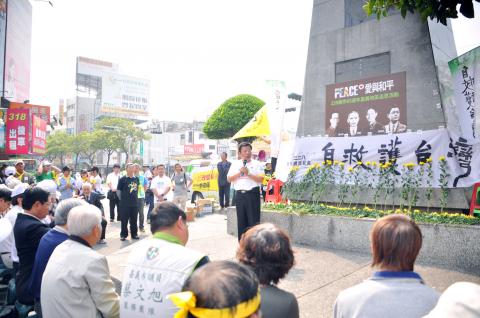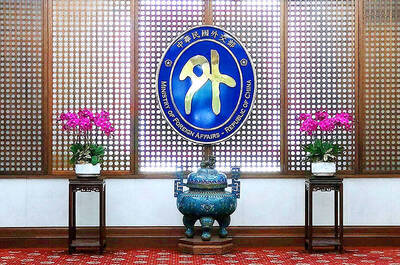Vice President Vincent Siew (蕭萬長) yesterday paid tribute to a prominent victim of the 228 Massacre, Dr Pan Mu-chih (潘木枝), at a commemorative exhibition held to mark the 65th anniversary of his execution and to honor his dedication to the development of democracy in Taiwan.
Joined by family members of victims of the 228 Massacre, Siew attended the memorial exhibition titled: “The burning incense stick: 65 years of memories of the late doctor Pan Mu-chih,” held by the Memorial Foundation of 228.
Not long after the 228 Incident had begun, Pan conducted negotiations with Chinese Nationalist Party (KMT) troops at Chiayi Airport on behalf of that city’s 228 Settlement Committee. However, he was detained by government troops during the negotiations and was executed in front of Chiayi Railway Station on Mar.25, 1947.

Photo: Wang Shan-yen, Taipei Times
The 228 Massacre refers to a bloody crackdown by KMT troops on an anti-government uprising that began on Feb. 27, 1947.
“Doctor Pan was not only my life-saver, but my mentor,” Siew said in a memorial film for Pan titled Died for the people, died with honor (為市民而亡,身雖死猶榮), which premiered at the exhibition yesterday.
Siew said Pan’s public execution left a lasting and a distressing memory because he had often received care from the doctor as a child.
“My mother had once said to me that without doctor Pan, I might not have lived to adulthood. He was a kind man not only to me, but also to each and every one of his patients,” Siew said.
Aside from his devotion to his patients, Pan also had been a key influence in Taiwan’s democratic development: He gave his life for Taiwan and for the people of Chiayi, Siew said.
“To commemorate the selfless sacrifice of doctor Pan, we must move forward with Taiwan’s democratic development and set the nation on a better direction,” Siew said.
The commemorative exhibition opened yesterday in the National 228 Memorial Museum and is scheduled to run through April 29.
Translated by Stacy Hsu, Staff Writer

The Ministry of Foreign Affairs (MOFA) yesterday voiced dissatisfaction with the Comprehensive and Progressive Agreement for Trans- Pacific Partnership (CPTPP), whose latest meeting, concluded earlier the same day, appeared not to address the country’s application. In a statement, MOFA said the CPTPP commission had "once again failed to fairly process Taiwan’s application," attributing the inaction to the bloc’s "succumbing to political pressure," without elaborating. Taiwan submitted its CPTPP application under the name "Separate Customs Territory of Taiwan, Penghu, Kinmen and Matsu" on Sept. 22, 2021 -- less than a week after China

ALIGNED THINKING: Taiwan and Japan have a mutual interest in trade, culture and engineering, and can work together for stability, Cho Jung-tai said Taiwan and Japan are two like-minded countries willing to work together to form a “safety barrier” in the Indo-Pacific region, Premier Cho Jung-tai (卓榮泰) yesterday said at the opening ceremony of the 35th Taiwan-Japan Modern Engineering and Technology Symposium in Taipei. Taiwan and Japan are close geographically and closer emotionally, he added. Citing the overflowing of a barrier lake in the Mataian River (馬太鞍溪) in September, Cho said the submersible water level sensors given by Japan during the disaster helped Taiwan monitor the lake’s water levels more accurately. Japan also provided a lot of vaccines early in the outbreak of the COVID-19 pandemic,

Kaohsiung Mayor Chen Chi-mai (陳其邁) on Monday announced light shows and themed traffic lights to welcome fans of South Korean pop group Twice to the port city. The group is to play Kaohsiung on Saturday as part of its “This Is For” world tour. It would be the group’s first performance in Taiwan since its debut 10 years ago. The all-female group consists of five South Koreans, three Japanese and Tainan’s Chou Tzu-yu (周子瑜), the first Taiwan-born and raised member of a South Korean girl group. To promote the group’s arrival, the city has been holding a series of events, including a pop-up

A home-style restaurant opened by a Taiwanese woman in Quezon City in Metro Manila has been featured in the first-ever Michelin Guide honoring exceptional restaurants in the Philippines. The restaurant, Fong Wei Wu (豐味屋), was one of 74 eateries to receive a “Michelin Selected” honor in the guide, while one restaurant received two Michelin stars, eight received one star and 25 were awarded a “Bib Gourmand.” The guide, which was limited to restaurants in Metro Manila and Cebu, was published on Oct. 30. In an interview, Feng Wei Wu’s owner and chef, Linda, said that as a restaurateur in her 60s, receiving an